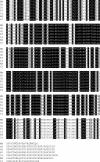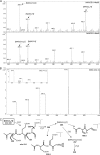N-acetylaspartylglutamate synthetase II synthesizes N-acetylaspartylglutamylglutamate
- PMID: 21454531
- PMCID: PMC3089511
- DOI: 10.1074/jbc.M111.230136
N-acetylaspartylglutamate synthetase II synthesizes N-acetylaspartylglutamylglutamate
Abstract
N-Acetylaspartylglutamate (NAAG) is found at high concentrations in the vertebrate nervous system. NAAG is an agonist at group II metabotropic glutamate receptors. In addition to its role as a neuropeptide, a number of functions have been proposed for NAAG, including a role as a non-excitotoxic transport form of glutamate and a molecular water pump. We recently identified a NAAG synthetase (now renamed NAAG synthetase I, NAAGS-I), encoded by the ribosomal modification protein rimK-like family member B (Rimklb) gene, as a member of the ATP-grasp protein family. We show here that a structurally related protein, encoded by the ribosomal modification protein rimK-like family member A (Rimkla) gene, is another NAAG synthetase (NAAGS-II), which in addition, synthesizes the N-acetylated tripeptide N-acetylaspartylglutamylglutamate (NAAG(2)). In contrast, NAAG(2) synthetase activity was undetectable in cells expressing NAAGS-I. Furthermore, we demonstrate by mass spectrometry the presence of NAAG(2) in murine brain tissue and sciatic nerves. The highest concentrations of both, NAAG(2) and NAAG, were found in sciatic nerves, spinal cord, and the brain stem, in accordance with the expression level of NAAGS-II. To our knowledge the presence of NAAG(2) in the vertebrate nervous system has not been described before. The physiological role of NAAG(2), e.g. whether it acts as a neurotransmitter, remains to be determined.
Figures










Similar articles
-
Molecular characterization of N-acetylaspartylglutamate synthetase.J Biol Chem. 2010 Sep 17;285(38):29156-64. doi: 10.1074/jbc.M110.111765. Epub 2010 Jul 19. J Biol Chem. 2010. PMID: 20643647 Free PMC article.
-
Mice deficient in the NAAG synthetase II gene Rimkla are impaired in a novel object recognition task.J Neurochem. 2021 Jun;157(6):2008-2023. doi: 10.1111/jnc.15333. Epub 2021 Mar 17. J Neurochem. 2021. PMID: 33638175
-
Molecular identification of N-acetylaspartylglutamate synthase and beta-citrylglutamate synthase.J Biol Chem. 2010 Sep 24;285(39):29826-33. doi: 10.1074/jbc.M110.152629. Epub 2010 Jul 24. J Biol Chem. 2010. PMID: 20657015 Free PMC article.
-
Advances in understanding the peptide neurotransmitter NAAG and appearance of a new member of the NAAG neuropeptide family.J Neurochem. 2011 Aug;118(4):490-8. doi: 10.1111/j.1471-4159.2011.07338.x. Epub 2011 Jul 1. J Neurochem. 2011. PMID: 21644997 Free PMC article. Review.
-
A role for N-acetylaspartylglutamate (NAAG) and mGluR3 in cognition.Neurobiol Learn Mem. 2019 Feb;158:9-13. doi: 10.1016/j.nlm.2019.01.006. Epub 2019 Jan 7. Neurobiol Learn Mem. 2019. PMID: 30630041 Free PMC article. Review.
Cited by
-
The regulatory role of NAAG-mGluR3 signaling on cortical synaptic plasticity after hypoxic ischemia.Cell Commun Signal. 2022 Apr 20;20(1):55. doi: 10.1186/s12964-022-00866-8. Cell Commun Signal. 2022. PMID: 35443669 Free PMC article.
-
Effects of Feeding Fermented Cassava Leaves on Intestinal Morphology, Cecal Microbiota, and Metabolome in Hybrid Geese.Microorganisms. 2025 Mar 14;13(3):660. doi: 10.3390/microorganisms13030660. Microorganisms. 2025. PMID: 40142552 Free PMC article.
-
ATP-binding Cassette Subfamily C Member 5 (ABCC5) Functions as an Efflux Transporter of Glutamate Conjugates and Analogs.J Biol Chem. 2015 Dec 18;290(51):30429-40. doi: 10.1074/jbc.M115.692103. Epub 2015 Oct 29. J Biol Chem. 2015. PMID: 26515061 Free PMC article.
-
Identification of an amino acid metabolism-associated gene signature predicting the prognosis and immune therapy response of clear cell renal cell carcinoma.Front Oncol. 2022 Sep 8;12:970208. doi: 10.3389/fonc.2022.970208. eCollection 2022. Front Oncol. 2022. PMID: 36158645 Free PMC article.
-
Immunohistological and electrophysiological evidence that N-acetylaspartylglutamate is a co-transmitter at the vertebrate neuromuscular junction.Eur J Neurosci. 2013 Jan;37(1):118-29. doi: 10.1111/ejn.12027. Epub 2012 Nov 8. Eur J Neurosci. 2013. PMID: 23134476 Free PMC article.
References
-
- Curatolo A., D'Arcangelo P., Lino A., Brancati A. (1965) J. Neurochem. 12, 339–342 - PubMed
-
- Coyle J. T. (1997) Neurobiol. Dis. 4, 231–238 - PubMed
-
- Neale J. H., Bzdega T., Wroblewska B. (2000) J. Neurochem. 75, 443–452 - PubMed
-
- Wroblewska B., Wroblewski J. T., Pshenichkin S., Surin A., Sullivan S. E., Neale J. H. (1997) J. Neurochem. 69, 174–181 - PubMed
MeSH terms
Substances
LinkOut - more resources
Full Text Sources
Molecular Biology Databases

